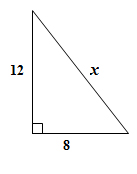You can use the Pythagorean Theorem to find missing side lengths of right triangles and to solve interesting application problems. It is important to note that not all problems will have whole number answers. Round your answer to the nearest tenth unless you are told otherwise.
Example 1: The triangle below is a right triangle. Solve for x.

- The Pythagorean Theorem is ____?____
Interactive popup. Assistance may be required.
Check Your Answer
- Substitute the lengths of the
legs values in for a and b: ____?_____
Interactive popup. Assistance may be required.
Check Your Answer
- Square the numerical values:____?_____
Interactive popup. Assistance may be required.
Check Your Answer
- Add:____?____
Interactive popup. Assistance may be required.
Check Your Answer
- Take the square root of both sides: ____?_____
Interactive popup. Assistance may be required.
Check Your Answer
- Since 208 is not a perfect square, simplify to the product of the largest perfect square factor and the remaining factor: ____?_____
Interactive popup. Assistance may be required.
Check Your Answer
- Simplify both radicals: ____?_____ ***NOTE: Since the radicals represent lengths only the positive value is used.
Interactive popup. Assistance may be required.
Check Your Answer
- Substitute x, the length of the hypotenuse, for c: ____?____
Interactive popup. Assistance may be required.
Check Your Answer
- Use a calculator. Round to the nearest tenth: ___?____
Interactive popup. Assistance may be required.
Check Your Answer
The length of the hypotenuse is 14.4.










